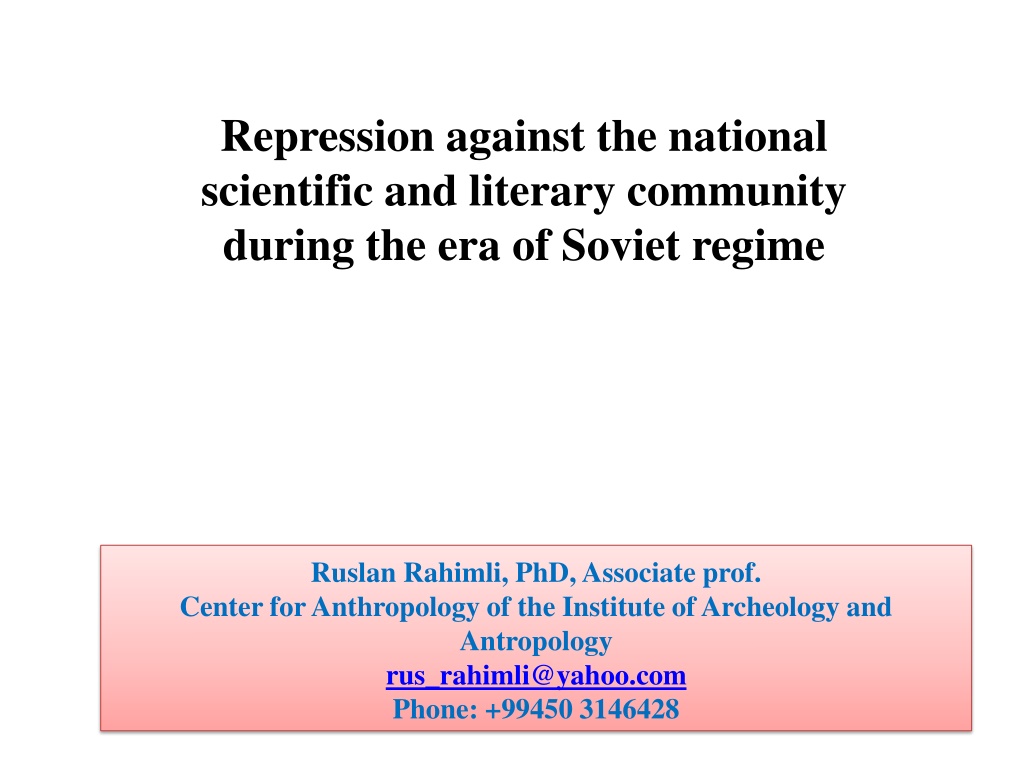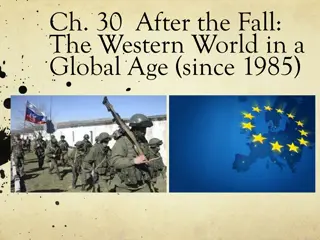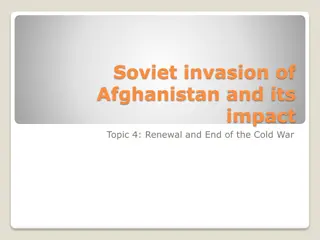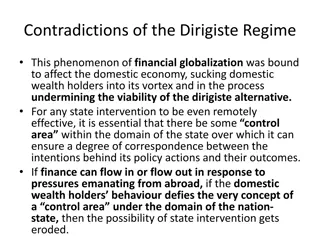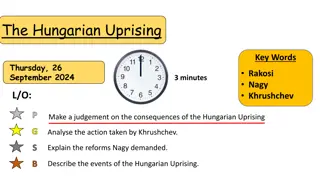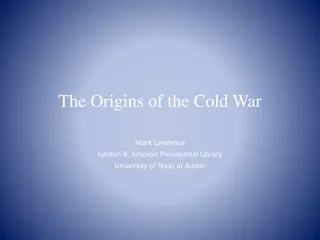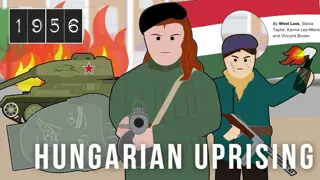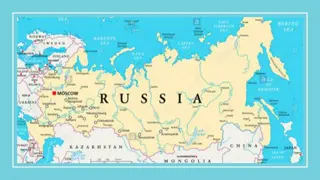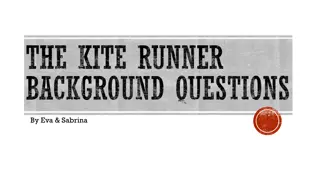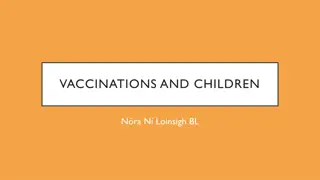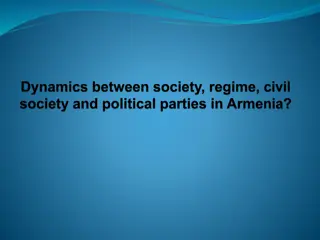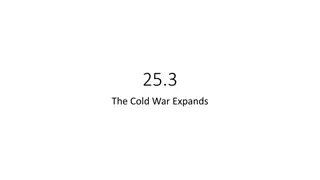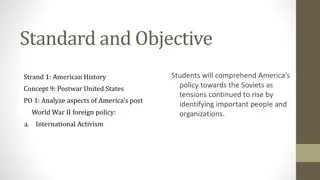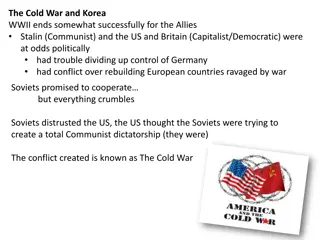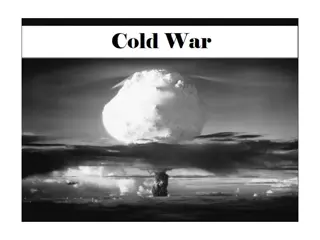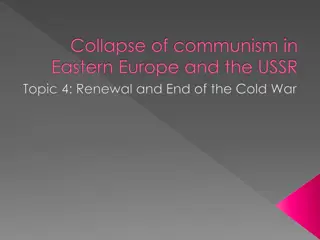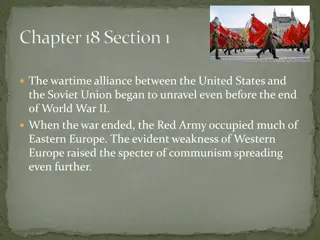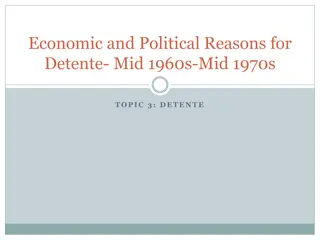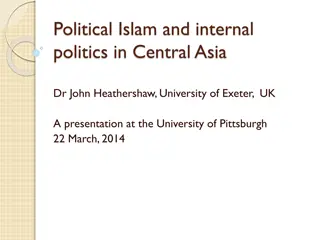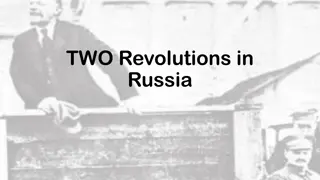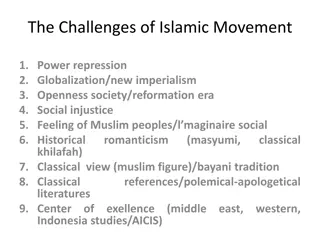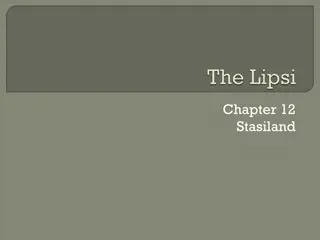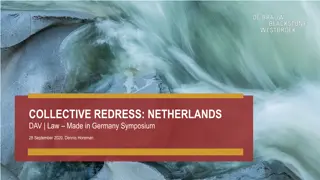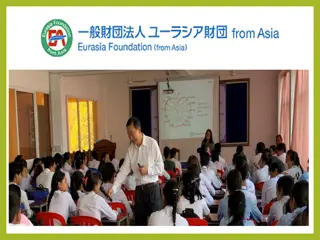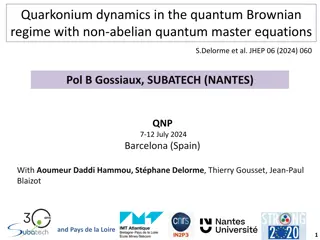Repression Against Azerbaijani Intellectuals During Soviet Regime
The era of Soviet regime in Azerbaijan was marked by severe repression against the national scientific and literary community. From early Bolshevik governance in 1920 to the 1930s, countless individuals, including prominent intellectuals, government members, and ordinary citizens, faced unjust trials, exile, and execution. The repressions intensified in the 1930s, with the intelligentsia being targeted for elimination. The creation of border lines and accusations of espionage further fueled the wave of repression, leading to widespread suffering and displacement among Azerbaijanis.
Download Presentation

Please find below an Image/Link to download the presentation.
The content on the website is provided AS IS for your information and personal use only. It may not be sold, licensed, or shared on other websites without obtaining consent from the author. Download presentation by click this link. If you encounter any issues during the download, it is possible that the publisher has removed the file from their server.
E N D
Presentation Transcript
Repression against the national scientific and literary community during the era of Soviet regime Ruslan Rahimli, PhD, Associate prof. Center for Anthropology of the Institute of Archeology and Antropology rus_rahimli@yahoo.com Phone: +99450 3146428
Starting from early years of governance of Bolsheviks in Azerbaijan from 1920 thousands peoples was shot dead by NKVD (former DTK) commissars. There was not any court for investigation was a accused person guilty or not. They shat dead former member of ADR government, beys, rich persons only persons who have 10- 20 cows, horses. In some cases prosecution lasts 3-5 minutes and accused person was shot dead. In this years a lot of prominent Azerbaijani intellectuals, ADR government members mainly suffered from repression. Some of them were shot dead and some exiled and others find opportunity to leaveAzerbaijan forever. Also hundreds peoples from Azerbaijan was exiled to Kazakhstan or Siberia with no permission to returm back. They could not return to their homeland because Bolsheviks s court did not allowed to return back who coming back was jailed for 15-20 years. Families of accused persons also suffered from repressions and they also was exiled to mainly to Kazakhstan.
Second wave of repressions did not start in 1937, but in1930. When the First Deputy Chairman of the People's Commissars of the USSR, V.M. Molotov, made a speech before the New Year, he expressed the opinion that the 30th year will be the last year in which the intelligentsia lived in peace. After that, a wave of repression began, albeit mildly. On December 1, 1936, Sergey Mironovich Kirov was assassinated in Leningrad, his body was brought to Moscow on the 4th of the month. A few days later, by the decision of the Central Committee, emergency triads were created. I.O. Matulevich, I.M. Zaryanov and Y.K. Jigur were sent to Baku.
It was planned to create border lines in some republics "in order to strengthen the protection of the state border with Iran and Afghanistan". In Azerbaijan, all regions of Nakhchivan MSSR, Astrakhanbazar, Bilasuvar, Jabrayil, Zangilan, Zuvand, Garadonlu, Garyagin, Lankaran and Masalli regions were included in this line. Azerbaijan's border with Iran, the factor of southern Azerbaijanis, where was living and right now millions of Azerbaijanis and the factor of a divided nation, the factor of Turkey, and Azerbaijan s location in a sensitive geography were also a sign that the wave of repression in Azerbaijan would be stronger. Azerbaijanis lived not only in the territory of the Republic of Azerbaijan they also lived in the territory of neighboring Georgia and Armenia. The main reason was that they were as Soviet authorities said "spies" of neighboring Turkey. Astara,
Old underground party members were declared enemies of the Soviet Union, party leaders and Soviet workers very easily attracted each other to different counter-revolutionary organizations, Russian workers fought for the establishment of bourgeois-nationalist power in Azerbaijan, and old professors were fighters of terrorist groups. as they were noted. During the years of Bolshevikization, more than 400,000 people faced exile, murder, rebellion and various physical and mental tortures. You don't want to believe the facts in the archive materials that shake people and bring them to a state of stress. So, as a result of research, we determined that only in Baku city from June 29, 1920 to January 1921, 142 people, from January 1921 to January 1922, 88 people, from January 1922 to January 1923, 135 people , 89 people from January 1923 to January 1924, 59 people from January 1924 to January 1925... were shot, on only one day of 1937 - September 8, which we consider to be the peak, culmination of political repressions. 217 people were murdered on the night of 9 to 11.
In the spring of 1936, a group of former Trotskyists working in the field of humanitarian sciences were arrested in Baku. Then the "nationalists" were arrested. First, publicist Ahmet Trinich of Albanian origin, who was in hostile relations with Mirjafar Bagirov, who was the head of the republic at that time, was arrested. In April of the same year, at the meeting of the Central Committee of the Communist Party of the Azerbaijan SSR, Bagirov read a found or fabricated letter containing Trinich's request for the defense of the Musavat parliament in 1918. As a result, Trinich was expelled from the party and arrested, and during the investigation, he killed himself by pushing a button. However, the first major wave of arrests in Azerbaijan took place in the fall and mainly targeted dissidents within the Bolshevik party, members of neo-Bolshevik parties, and those suspected of disloyalty to the Soviet authorities. In November, dozens of prominent communists were arrested by the KhDIK, accused of Trotskyism, dissension and espionage. Even Bagirov's personal secretary Nikishov was arrested as a "Musavat agent" and "terrorist". Rector of Azerbaijan State University Balabey Hasanbayov, director of Azernashr Ibrahim Eminbeyli, well-known ethnologist, professors A.S. Bukshpan and Nikolayev, member of the Supreme Court Orbelyan, chairman of the Union of the Fighting Godless Adib Veli Khuluflu were expelled from the party and arrested.
By the fall of 1938, repressions in Azerbaijan reached their peak. Regardless of their nationality, people were subjected to repressions. In 1937, 57 directors of factories and production enterprises, 95 engineers, 207 Soviet and trade union workers, and 8 professors were arrested inAzerbaijan. Almost all of them were shot dead or exiled. In 1937, 2,792 people were shot and 4,425 people were sentenced to long-term imprisonment for political crimes by the triumvirate alone.
During the years of the existence of the ADR, many young Azerbaijanis received education outside the republic: in European countries and Turkey.After the establishment of Soviet power in their homeland, a sad fate awaited them: persecution, arrests, executions. In the 30-40s. they were arrested as German , English , Turkish spies, and their families were evicted outside the republic.In 1937-38 thousands of orphans were sent to Russian orphanages for children of enemies of the people. Their fathers were shot and their mothers were sentenced to 8-10 years. If before 1937 as a result of the so-called After dispossession, seven people were evicted from their homes for a period of 3-5 years, but starting in May 1937, by decree of the NKVD, people began to be evicted forever without the right to return again. Those who violated this decree faced a 20-year hard labor exile.
Those who were repressed in Azerbaijan had 4-5 specific accusations. 1. Conspiracy against Stalin in the Center and Bagirov in Azerbaijan. 2. Pan-Turkism, Musavatism. 3. Being a member of a counter-revolutionary organization and nationalist activity (communists were mostly accused of their political position before 1917). 4. Creation of a common Turkish-Tatar state. 5. Separation of the national republics from the USSR by armed means (because it was allowed to leave voluntarily, albeit formally), etc. But in other countries, different accusations were made.
Each accused was interrogated by NKVD investigators for 15-20 minutes. Within 15 minutes, both defendants were brought, interrogated, and a protocol was prepared.Only the interrogation of Ayna Sultanova took 57 minutes. . Interrogation of great scientists and personalities took a little longer, because they could not prove anything. The extraordinary triads were given great powers. Their decision could not be challenged or appealed, the order had to be carried out immediately. Ziya Bunyadov, a prominent scientist of Azerbaijan, made this calculation and came across terrible numbers. In these two years (1937-1938), 27,854 Azerbaijanis were subjected to repression. We can say that almost every day 97 person was prosecuted.
To avoid arrest, some communists either went insane or killed themselves. In the summer of 1937, R.I. Gulbis, head of Azneft, threw himself under a train after learning that he would soon be arrested at the Baku railway station. The brightest representatives of socialism, such as Dadash Bunyadzade, Sultanmajid Efendiyev, Hamid Sultanov, his wife Ayna Sultanova, Teymur Aliyev, Ruhulla Akhundov, Huseyn Rahmanov, Chingiz Yildirim, Mirza Davud Huseynov, Mustafa Guliyev, Aliheydar Garayev, Gazanfar Musabayov, Isay Dovletov, were victims of repression
The newly established Soviet regime had to eliminate the intellectuals in order to maintain itself and maintain its superiority. The collective farmers joined every call without realizing it. The intellectuals had already begun to understand everything. The regime first eliminated the intellectuals because they felt that they would see the truth and realize that the Bolsheviks were only making promises. Although the word repression means to punish, in the Soviet era it already performed the function of destruction, elimination. In other words, the act of repression was carried out during the period of Tsarist Russia. Starting from Kasim Bey Zakir, Azerbaijan well known, prominent poet who chased by Tsarist Russia as other intellectuals. But there was a mechanism of punishment, which had not yet risen to the point of destruction. Well, it had a name - White Guard, White terror. But in Soviet time the color has changed and it become red terror. We can say that blood has become a symbol of repression...
During the repressive actions, the Bolsheviks chose intellectuals and creative people as targets from the first day. Our literary historian, editor and teacher Firidun Bey, editor Piri Murselzade, teacher Islam Bey Qabulzade, teachers Mirza Abbas, Gasim Gasimzadeh, Huseyn Muzaffar, dr. Rafibeyli, Zarif Efendi and others are among the first victims who were shot dead. Although the shooting of the prominent critic-scientist, wonderful educator Firidun Bey Kocherli in 1920 in Kirovobad (now Ganja city) was hidden from the literary and scientific community for a long time, there was no news from him. The Azerbaijani student Gultekin gave detailed information about it through the magazine "Yeni Gafkasiya" and showed that the communists were bloody when they extended their claws to the Caucasus, they found a patriotic teacher like F. Kocherli in charge of his duties in the "Kazakh" gymnasium and executed him.
Prominent Azerbaijani pedagogue, literary critic and publicist. He was a member of the National Council of the Azerbaijan Democratic Republic. In 1918-1920, Kocherli was elected to the Parliament of the Azerbaijan Democratic Republic. In 1910, he was appointed a temporary instructor of the Azerbaijani branch of the Gori gymnasium . In 1918-1920, he worked as a director at the Kazakh Teachers' Seminary, which was established on the basis of that gymnasium on his initiative. After the suppression of the Ganja rebellion in 1920, he was arrested and shot dead by a special department of the XI Army.
In the 1920s and 1930s, Baku was the center of the cultural life of all Turkic peoples. The most prominent intellectuals of Tatarstan, Uzbekistan, Crimea, and Turkey lived and worked here. It can be said that most of them changed their lives as a result of these repressions. According to American historian Tadeusz Svetokhovsky, intellectuals were the main victims of repression. 29 thousand intellectuals were sentenced to death. As Svetokhovsky noted, "intellectuals with a sense of historical mission and social power had lost their existence. In 1937-1938, Azerbaijani literature suffered the most from repression in Transcaucasia[100]. Among those subjected to repression, writers formed before the revolution prevailed, but along with them, a group of writers formed during the Soviet period were also subjected to repression.As early as May 17, "Communist" and "Bakinski Rabochi" newspapers published articles against poets Ahmet Javad, Huseyn Javid, as well as writers attributed to Musavatists, Pan-Turks, and nationalists. Articles against poets and writers were published in the newspapers "Literature", "Young Worker", New way", "Attack", Revolution and culture" magazines.
Azerbaijani writers who were repressed in 1937 In 1937-1938, Azerbaijani literature suffered the most from repression in Transcaucasia. Among those subjected to repression, there were more writers formed before the revolution, but along with them, a group of writers formed during the Soviet period were also subjected to repression As early as May 17, 1937, articles against poets Ahmet Javad, Huseyn Javid, as well as writers attributed to Musavatists, Pan-Turks, and nationalists appeared in "Communist" and "Bakinskiy Rabochiy" newspapers. On the night of June 4, 1937, Ahmet Javad, Mikayil Mushfiq, Huseyn Javid, Haji Karim Sanil and Atababa Musakhanli were arrested.
In January 1940, an arrest warrant was issued for the writer Yusif Vazirov, known by the nickname Chamanzaminli, based on the statements of a number of people who were subjected to repression. Back in 1937, for his novel "Students", Vazirov was expelled from the Azerbaijan Writers' Union and released from all his positions. In this regard, Vazirov is forced to go to the city of Urgenj. Here he teaches at the Institute of Teachers. In 1940, Vazirov was arrested in the city of Urganj and brought to Baku. He was sentenced to a correctional labor camp for 8 years for participating in a counter-revolutionary Musavatist-nationalist organization and for carrying out pan-Turkic and Trotskyist propaganda. He died on January 3, 1943 in the Unjlag camp at the Sukhobezvodnoe station.
Taghi Shahbazi, writer and former rector of ASU, was arrested in July 1937. He was accused of being a "member of a counter- revolutionary nationalist organization." On January 2, 1938, Shahbazi was sentenced to the highest punishment and shot on the same day.
Omar Faig Nemanzadeh was arrested in the summer of 1937 in Akhalsikhe in his homeland, on July 16 by the order of district prosecutor Odabasyan, and 3 months later, on October 10, he was shot by the decision of the "Trio" under the People's Commissariat of Internal Affairs of the Georgian SSR. In 1958, the Supreme Court of the Georgian SSR acquitted him. The study of Omar Faig's life and the collection and publication of his rich collection began only after the mid-1980s. Omer Faig L men oghlu Nemanzade was born on December 24, 1872 in Azgur village, Akhalsikh district, Tiflis governorate. Azerbaijani writer, social and political figure, Molla Nasreddin, publicist, pedagogue, owner of "Geyrat" printing house and co-founder of "Molla Nasreddin" magazine, Revolutionary Committee of the Georgian SSR and the 1st Chairman of the Council on Muslim Affairs of the Georgian SSR member of the Provisional
In general, at that time, almost half of the members of the Union of Writers of Azerbaijan were subjected to repression. Among them were Sultan Majid Ganiyev, Mammad Kazim Alakbarli, Said Huseyn and others.
Poet, translator, member of AYB, professor Ahmet Javad is the author of the words of the Azerbaijani national anthem. After the establishment of the Soviet government, he was the head of the Department of Public Education in Guba (1920 1922), a teacher, associate professor, head of the department of Azerbaijani and Russian languages at the Azerbaijan Agricultural Institute in Ganja (1930 1933), editor in the translation department of the Azerbaijan State Publishing House (1934), "Azerbaijanfilm". worked in different places as the director of documentary films department (1935-1936) in his studio.
For some time he was a member of the Musavat party, and even in 1923 he was arrested on charges of secret activity against the state and having a special role in the escape of Mirzabala Mammadzadeh, one of the leaders of the "Musavat" party. 1925, the poem "Sky-Lake" written by A.Javad was labeled a counter-revolutionary poem by a group of colleagues, and the poet was put in prison. In March 1937, despite being awarded the first prize for the translation of Shota Rustaveli's "The Knight in the Panther's Skin ", he was arrested on June 4 of the same year. The poet is charged with counter-revolutionary activities, membership of the outlawed party called Musavat, writing anti-government poems and nationalist activities. Defenders, that is, lawyers and witnesses, were not present at the trial. In 1937, the verdict was read on October 12, based on the false accusation brought against the poet. The trial, which began on October 12, lasted only 15 minutes, and the poet was shot on the night of October 12-13. On that night, along with Ahmet Javad, prominent writer Buyukaga Talybli was also shot. His wife Shukriya Khanim was exiled to Kazakhstan for 8 years because she was a "family member of a traitor."
Philosopher poet, great dramatist Huseyn Javid was one of the most powerful personalities of romanticism literary movement in the history of Azerbaijani literature. Huseyn Javid gained fame as the greatest representative of modern Azerbaijani romanticism in the first ten years of his work. Russian scholars such as F.D.Ashnin, V.M.Alpatov, and D.M.Nasilov believe that Huseyn Javid was the most influential among the writers imprisoned at that time. It should be noted that the newspapers of the 1920s used phrases such as "the most famous and most famous poet of the Caucasus" and "the most powerful poet of Azerbaijan" when writing about him. Noting that iin March 1930, the play "Prince" was performed for the first time at the Tbilisi State Red Army Theater. His magnificent works was Sheyx Sanan, Timur the Lame, Sayavush, Iblis, Propet
1915 year he worked as a teacher also in Tbilisi. The reason for his arrest were accusations such as "maintaining counter-revolutionary relations", "conducting slanderous conversations with a number of musavists", "collecting around him young poets rooted in nationalist thoughts and improving them in a musavist spirit". Article 68 (espionage) was added to the charges when the case is re-examined in Baku. According to the final indictment, there sadi "it was established that Huseyn Javid lived in Turkey for a long time and later in Germany. Huseyn Javid was deported to Siberia to a prison camp in Taishet district of Irkutsk region. He died on December 5, 1941 in the prison hospital for disabled people of Taishet district, Irkutsk region.
Mikayil Mushvig was Azerbaijani poet, translator and pedagogue, member of Azerbaijan Writers' Union (1934), former editor of "Azernashr". 30-year-old young poet Mikayil Mushfig also became a victim of 1937 repressions. On May 27, 1937, the NKVD report prepared by security captain Chinman stated that "Mikayil Mushfig is currently in contact with the Musavat youth organization and does not hesitate to slander the party and the government. In addition, the reference alleged that Mushfig wanted to create discontent among the people with his inflammatory words such as "Azerbaijan does not have its own freedom, it lives in a Russian colony. During the interrogation, the poet was asked whether he was a member of a counter-revolutionary organization and took a counter-revolutionary nationalist position, but the poet said that he was not a member of a counter-revolutionary nationalist organization and did not take a counter-revolutionary nationalist position.
In the indictment signed by NKVD chief Sumbatov and chief assistant of the USSR prosecutor Rozovsky, "as a result of defending counter-revolutionaries from 1926 to 1930, Almaz Ild r mzade and Nasir Guluzade were accused of preparing Ismayilzade Mikayil Mushfig Gadir oglu in a counter-revolutionary spirit. The indictment stated that during 1930-1930 years Mushvig was a member of the brutal counter-revolutionary nationalist Musavat organization. In almost all cases, there is a statement that he "confessed" that he was working against the Soviet state, and this statement was included in the indictment for Mushfiq as well. It is clear that the investigators got this answer by severely torturing the accuseds On January 5, 1938, a 20-minute court session of the Supreme Court of the USSR decided to shoot Mushfiq.[14] The sentence will be executed on January 6 on Nargin Island.
Repressions against scientists Repressions in the Azerbaijan branch of the Academy of Sciences of the USSR on the case of "All-Union Pan-Turk Organization". Repressions in the Azerbaijan branch of the Academy of Sciences of the USSR and in the universities began in December 1936 with the arrest of RuhullaAkhundov. Already in January 1937, a number of Azerbaijani scientists were arrested. These are Hanafi Zeynalli, Vali Khuluflu and Bekir Chobanzade amd others. They even arrested Bekir Chobanzade in a sanatorium in Kislovodsk and brought him to Baku in a special convoy. On March 18, 1936, historian Gaziz Gubaidullin was also arrested. On March 19-20, speaking at the March 6 plenum of the Central Committee of the Azerbaijan SSR, Mir Jafar Bagirov, talking about the nationalist work led by R. Akhundov on the cultural front, declared that professors Bekir Chobanzade and Gaziz Gubaidullin are the brightest representatives of pan-Turkism in Azerbaijan.
Gaziz Gubaidullin is accused of being "one of the main ideologists of pan-Turkism in the territory of the USSR". He was accused of "committing harmful acts at production sites in Azerbaijan" and espionage (for Turkish, Japanese, German intelligence). Bekir Chobanzade was charged with articles 60, 63, 70, 73 of the Criminal Code of the Azerbaijan SSR. Khalid Said Khojayev was accused of being a member of the organization and an "old Turkish intelligence officer" even if he was not named among the leaders of the organization. The court proceedings held on October 11-13 included Bekir Chobanzade, Gaziz Gubaidullin, Hanafi Zeynalli, Huseynali Bilandarli, B. Tikhomirov (rector of the Institute of Party History and dean of the Faculty of History of ASU), A. Bukshpan, Khalid Said Khocayev, Abdulaziz Salamzade, Balabey Hasanbayov. scientists and party leaders such as Mirza Davud Huseynov and Mammad Juvarlinski were sentenced to death. Those sentenced to death during these days were shot on the last day of the trial - October 13, 1937.
Beki Chobanzade was a prominent Azerbaijani scientist and his scientific works are still studied by researchers. After the book "From Nationalism to Internationalism" written by the scientist, Chobanzade was declared the ideologue of the nationalist bourgeoisie. Chobanzade was subjected to merciless criticism. "Revolution and Culture" magazine published a series of articles "against Prof. Chobanzade's political and literary views", accusing Chobanzade of pan-Turkism and Kemalism.On January 28, 1937, the professor, who was resting with his wife in Kislovodsky's "Gornyak" sanatorium, was arrested and taken to Pyatigorsk prison, and from there to the detention center of the People's Commissariat of Internal Affairs of the Azerbaijan SSR. On October 12, after about 15 minutes of trial, he was sentenced to death. The verdict was executed on October 13, 1938.Bekir Chobanzade's burial place is unknown.
22. Jump up to:1 2 3Anin, Alpatov, Nasilov, 2002. sh. 66 23. Jump up to:1 2 3 4 5 6 7 8 9 10 11 12 smay lov, . " " (rus). ca-c.org. 2017-01-04 tarixind arxivl dirilib. stifad 24. Baberovski, Y., 2010. s h. 769 25. Jump up to:1 2 3 4Baberovski, Y., 2010. s h. 770 26. smay lov, 2015. s h. 78 79 27. Jump up to:1 2 . " - ". 1news.az. 9 avqust 2007. 28. Baberovski, Y., 2010. s h. 774 775 29. smay lov, 2015. s h. 87 30. smay lov, 2015. s h. 88 31. Baberovski, Y., 2010. s h. 775 32. Jump up to:1 2Baberovski, Y., 2010. s h. 775 776 33. , . ?.. : . Moskva 34. ., , , . . 00447. Moskva: ; 35. smay lov, 2015. s h. 114 36. Jump up to:1 2 3Eldar smay lov. 1945 1953 (PDF). Bak : Adilo lu. 2003. s h. 113. 37. , ., . , 1936 1938 . .: ( ); . . . 2010. 38. Jump up to:1 2 3 4 , , . . " 1937 1938 . 39. " (1899)" (rus). openlist.wiki. 29 mart 2019 tarixind arxivl dirilib. 40. . - - 41. " (1895)" (rus). openlist.wiki. 29 mart 2019 tarixind arxivl dirilib. 42. , , . . " 1937 1938 . 43. " - " (rus). openlist.wiki. 29 mart 2019 tarixind arxivl dirilib. 44. . . . 1918 1945 . .: . 2007. 142 143. ISBN 978-5-9533-1989-8. 2021-05-23 tarixind arxivl dirilib. stifad
